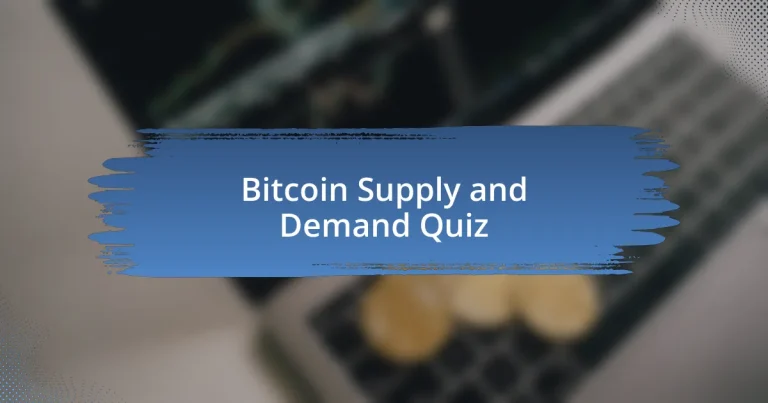
Start of Bitcoin Supply and Demand Quiz
1. What is the total supply of Bitcoin?
- 50 million
- 19 million
- 25 million
- 21 million
2. How many Bitcoins have been mined as of mid-2023?
- Approximately 18 million
- Approximately 19.4 million
- Approximately 21 million
- Approximately 20 million
3. What happens to the supply of new Bitcoins every four years?
- The supply of new Bitcoins doubles.
- The supply of new Bitcoins remains the same.
- The supply of new Bitcoins is halved.
- The supply of new Bitcoins triples.
4. How often does the Bitcoin halving occur?
- Approximately every four years.
- Every year.
- Every two years.
- Every six months.
5. What is the current block reward for mining a block?
- 6.25 new Bitcoins.
- 3.125 new Bitcoins.
- 1.5 new Bitcoins.
- 12.5 new Bitcoins.
6. What happens to the circulating supply of Bitcoin when a new block is mined?
- The circulating supply remains unchanged during mining.
- The circulating supply increases as more BTC is minted to reward miners.
- The circulating supply is only affected by market demand.
- The circulating supply decreases due to transaction fees.
7. What is the average time between new blocks being mined?
- Approximately 5 minutes
- Approximately 20 minutes
- Approximately 10 minutes
- Approximately 15 minutes
8. What percentage of the total supply of Bitcoin is currently in circulation?
- Approximately 75%.
- Approximately 85%.
- Approximately 94%.
- Approximately 50%.
9. What percentage of the total supply of Bitcoin is left to mine?
- Approximately 10%.
- Approximately 12%.
- Approximately 2%.
- Approximately 6%.
10. What happens to the supply of new Bitcoins once the maximum supply is reached?
- No new supply will enter the market.
- The supply will decrease gradually.
- The supply will double every year.
- New Bitcoins will continue to be mined indefinitely.
11. What is the expected year for Bitcoin to reach its maximum supply?
- 2100
- 2200
- 2140
- 2300
12. What is the primary reason for the price fluctuations of Bitcoin?
- The fixed number of transactions allowed.
- The fluctuating supply and demand.
- Government regulations on mining.
- The lack of mining technology.
13. How does the Bitcoin halving affect the supply of new Bitcoins?
- It keeps the supply of new Bitcoins stable.
- It increases the supply of new Bitcoins entering circulation.
- It reduces the supply of new Bitcoins entering circulation.
- It eliminates the supply of new Bitcoins completely.
14. What happens to the price of Bitcoin if demand remains steady or increases while supply decreases?
- The price of Bitcoin will fluctuate randomly.
- The price of Bitcoin will stabilize.
- The price of Bitcoin will fall.
- The price of Bitcoin can rise.
15. What is the role of miners in the Bitcoin network?
- Miners exclusively secure data on centralized servers.
- Miners collect transaction fees without any verification.
- Miners create new cryptocurrencies from scratch.
- Miners verify transactions and generate new Bitcoins.
16. How does the fixed supply of Bitcoin affect its price?
- It allows unlimited transactions, stabilizing the price.
- It increases the mining reward, which lowers prices.
- It ensures that Bitcoin will lose value over time.
- It introduces scarcity, which can drive up the price.
17. What is the effect of inflation on Bitcoin?
- Inflation arises when new BTC tokens enter circulation, but it is fixed and predictable.
- Inflation has no effect on Bitcoin`s market stability.
- Inflation causes Bitcoin to lose value uncontrollably.
- Inflation increases the number of Bitcoin available indefinitely.
18. What happens to Bitcoin once it reaches its maximum supply?
- Miners will no longer validate transactions.
- Bitcoin will begin to deflate in value.
- No new supply will enter the market.
- The price of Bitcoin will drop immediately.
19. How does the block time affect the circulating supply of Bitcoin?
- The circulating supply decreases with longer block times.
- The circulating supply remains constant regardless of block time.
- The circulating supply increases as more BTC is minted to reward miners.
- The circulating supply is unaffected by the mining process.
20. What is the significance of the Bitcoin halving event?
- It eliminates transaction fees for Bitcoin transfers.
- It reduces the number of new BTC tokens entering the supply every 10 minutes by 50%.
- It doubles the reward for miners every four years.
- It increases the number of Bitcoins mined per block.
21. What is the impact of the Bitcoin halving on the price of Bitcoin?
- It always results in price stability.
- Historically, it has led to prolonged price appreciation.
- It causes immediate price drops every time.
- It has no effect on price whatsoever.
22. What is the current circulating supply of Bitcoin?
- Approximately 18,500,000 BTC.
- Approximately 20,000,000 BTC.
- Approximately 19,722,500 BTC.
- Approximately 17,000,000 BTC.
23. What is the role of transaction fees in the Bitcoin network once it reaches its maximum supply?
- Transaction fees will reduce the value of Bitcoin significantly.
- Transaction fees will become obsolete with full supply.
- Transaction fees will be the primary source of revenue for miners.
- Transaction fees will be charged by users for wallet services only.
24. How does the fixed supply of Bitcoin differ from traditional currencies?
- Bitcoin supply can be adjusted based on economic needs.
- Traditional currencies can be `printed` at any time, whereas Bitcoin has a fixed supply.
- Traditional currencies have a fixed amount similar to Bitcoin.
- Bitcoin can be created infinitely just like traditional currencies.
25. What is the effect of reduced supply on the price of Bitcoin?
- The price of Bitcoin can rise.
- The price of Bitcoin remains unchanged.
- The price of Bitcoin goes to zero.
- The price of Bitcoin decreases.
26. What is the significance of the 21 million coin hard cap on Bitcoin’s supply?
- It allows for unlimited mining after 2140.
- It means that Bitcoin can be printed like traditional currency.
- It ensures that no more than 21 million Bitcoins will ever exist.
- It guarantees Bitcoin will always be cheaper than gold.
27. How does the scarcity of Bitcoin affect its price?
- Scarcity has no effect on the price of Bitcoin.
- Scarcity decreases the price due to less demand.
- Scarcity can drive up the price due to limited availability.
- Scarcity leads to an increase in Bitcoin mining rewards.
28. What is the impact of regulatory pressure on the demand for Bitcoin?
- Regulatory pressure can affect demand by influencing investor confidence.
- Regulatory pressure increases demand by ensuring greater market access.
- Regulatory pressure has no impact on the demand for Bitcoin whatsoever.
- Regulatory pressure decreases demand by reducing the number of Bitcoins mined.
29. How does media exposure influence the demand for Bitcoin?
- Negative media exposure consistently boosts demand for Bitcoin.
- Positive media exposure can increase demand by raising awareness and investor interest.
- Media exposure directly controls the price of Bitcoin.
- Media exposure has no relevance to Bitcoin demand at all.
30. What is the effect of competition on the price of Bitcoin?
- Competition has no impact on the price of Bitcoin.
- Increased competition automatically lowers Bitcoin`s value.
- Competition makes Bitcoin more stable in price.
- Competition from other cryptocurrencies can affect demand and, consequently, the price of Bitcoin.

Congratulations! You Have Successfully Completed the Bitcoin Supply and Demand Quiz
Completing this quiz on Bitcoin’s supply and demand dynamics is a fantastic way to enhance your understanding of this crucial topic. You’ve explored how Bitcoin’s limited supply interacts with increasing demand. This relationship is fundamental to its value and market behavior. Understanding these concepts empowers you to make informed decisions in the cryptocurrency landscape.
Throughout this quiz, you likely learned about the mechanisms that drive Bitcoin’s price volatility. The scarcity of Bitcoin, embedded in its code, plays a vital role in its appeal. You’ve also examined factors that influence demand, such as investor sentiment and market trends. This knowledge strengthens your ability to analyze market movements and trends effectively.
To continue your learning journey, we invite you to check the next section on this page. This resource dives deeper into Bitcoin’s supply and demand scenarios, offering further insights and analysis. Understanding these elements can help you navigate the complexities of the cryptocurrency market more confidently. Dive in and expand your knowledge today!

Bitcoin Supply and Demand
Understanding Bitcoin Supply
Bitcoin supply refers to the total quantity of Bitcoin that can exist. The maximum cap is set at 21 million coins. This limit is fundamental to Bitcoin’s design, preventing inflation. New Bitcoins are created through a process called mining, which rewards miners with coins for validating transactions. The issuance rate decreases over time in a process known as “halving,” occurring approximately every four years. Such measures establish scarcity, a key feature driving demand.
The Role of Demand in Bitcoin Markets
Demand for Bitcoin is influenced by various factors, including market sentiment, technological advancements, and regulatory changes. Increased demand can drive prices higher, as more investors seek to acquire Bitcoin. Demand often surges during economic uncertainty, as individuals may view Bitcoin as a hedge against traditional markets. Media coverage and social media trends also significantly impact public interest, quickly shifting perceptions and driving demand.
How Supply and Demand Affect Bitcoin Prices
Bitcoin prices fluctuate based on supply and demand dynamics. When demand exceeds supply, prices typically rise, reflecting increased competition among buyers. Conversely, if supply outpaces demand, prices tend to fall. Market participants monitor these trends closely. This relationship is influenced by traders’ speculation and long-term investment strategies. Price volatility is a hallmark of Bitcoin, shaped by these supply-demand interactions.
Market Influences on Bitcoin Supply
Several market factors influence Bitcoin supply, notably miner activity, network difficulty, and transaction fees. Mining profitability directly impacts how much Bitcoin is produced. As more miners join the network, the difficulty adjusts to maintain a consistent block production time. Additionally, transaction fees can incentivize miners, affecting overall supply. Events like Bitcoin halving also significantly influence supply changes, leading to market reactions.
The Impact of External Events on Bitcoin Demand
External events can dramatically influence Bitcoin demand. Economic crises, legislative changes, and technological breakthroughs can cause shifts in investor psychology. For example, announcements of regulatory acceptance can boost demand, whereas negative regulations can lead to panic selling. Events like the COVID-19 pandemic increased interest in alternative assets, elevating Bitcoin’s demand. Tracking these occurrences is crucial for understanding market behavior.
What is Bitcoin Supply and Demand?
Bitcoin supply and demand refers to the economic principles that govern the availability of Bitcoin and the desire of individuals to purchase it. The supply of Bitcoin is capped at 21 million coins, which creates scarcity. Demand fluctuates based on various factors, including market interest, investor behavior, and media coverage. This relationship impacts Bitcoin’s price; when demand exceeds supply, prices rise, and when supply exceeds demand, prices fall. Historically, significant events like halving and regulatory news can dramatically influence this dynamic.
How does Bitcoin Supply affect its Price?
Bitcoin supply affects its price through principles of scarcity and availability. With a fixed supply of 21 million coins, the price tends to rise when demand increases. Supply constraints, such as those created by the halving events that reduce the rate of new Bitcoin creation, often lead to price spikes. For example, after the halving events in 2012, 2016, and 2020, Bitcoin experienced sustained price increases as a response to reduced new supply.
Where can I find information on Bitcoin Supply and Demand?
Information on Bitcoin supply and demand can be found on various financial news websites, cryptocurrency market platforms, and blockchain analytics sites. Platforms like CoinMarketCap and Glassnode provide data on supply metrics, while websites like CoinDesk and CryptoSlate offer analysis and reporting on market demand trends. These resources present real-time data and insights into how supply and demand are currently influencing Bitcoin’s market dynamics.
When do supply and demand factors typically influence Bitcoin’s Price?
Supply and demand factors typically influence Bitcoin’s price in response to market events, such as halving, regulatory announcements, and macroeconomic conditions. Halving events, which occur approximately every four years, directly affect the supply of new bitcoins. Demand can also spike during economic uncertainty when investors seek alternative assets. For instance, during the COVID-19 pandemic in 2020, Bitcoin’s price surged due to increased demand as a hedge against inflation.
Who controls Bitcoin Supply?
The supply of Bitcoin is controlled by the software protocol of the Bitcoin network. This protocol dictates that only 21 million bitcoins will ever exist. New bitcoins are created through a process called mining, where miners validate transactions and add them to the blockchain. The mining reward halves approximately every four years, directly controlling the rate at which new bitcoins enter circulation. This decentralized control means no single entity can alter the maximum supply.


